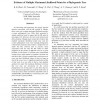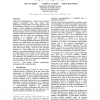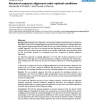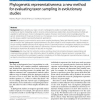129 search results - page 2 / 26 » An Investigation of Phylogenetic Likelihood Methods |
BIBE
2006
IEEE
13 years 11 months ago
2006
IEEE
An interesting and important, but largely ignored question associated with the ML method is whether there exists only a single maximum likelihood point for a given phylogenetic tr...
ALGORITHMICA
2006
13 years 5 months ago
2006
Phylogenetic analysis is an area of computational biology concerned with the reconstruction of evolutionary relationships between organisms, genes, and gene families. Maximum likel...
APBC
2004
13 years 6 months ago
2004
Undiscovered relationships in a data set may confound analyses, particularly those that assume data independence. Such problems occur when characters used for phylogenetic analyse...
BMCBI
2005
13 years 5 months ago
2005
Background: Multiple genome alignment is an important problem in bioinformatics. An important subproblem used by many multiple alignment approaches is that of aligning two multipl...
BMCBI
2010
13 years 5 months ago
2010
Background: Taxon sampling is a major concern in phylogenetic studies. Incomplete, biased, or improper taxon sampling can lead to misleading results in reconstructing evolutionary...




